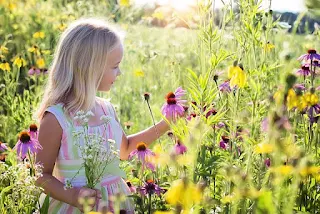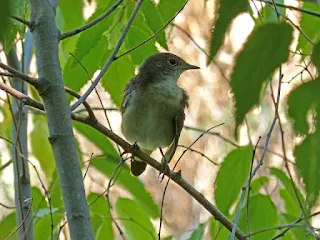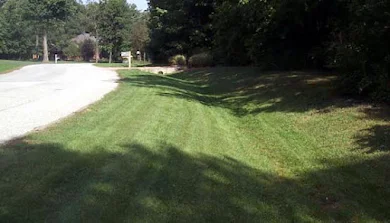Water harvesting is an essential aspect of sustainable landscaping that helps conserve water, reduce waste, and minimize the impact of droughts and water restrictions. Integrating water harvesting into no-lawn landscapes is an excellent way to create a water-efficient garden, supporting a more eco-friendly outdoor space. It's imperative for us all to figure out ways to utilize water better. When it's gone, it's gone!
The Importance of Water Harvesting in Sustainable Landscaping
Water harvesting plays a crucial role in sustainable landscaping in our ever warming globe. How?
- Reducing water consumption and waste: Water harvesting systems help capture and store water that would otherwise be lost to runoff or evaporation, reducing the need for additional water usage.
- Conserving natural resources: By decreasing the demand for water, water harvesting helps protect and conserve natural resources, such as rivers, lakes, and groundwater.
- Reducing dependence on municipal water sources: Water harvesting can provide a reliable source of water for gardens, reducing the reliance on municipal water supplies and lowering water bills.
- Minimizing the impact of droughts and water restrictions: Water harvesting systems enable gardens to withstand periods of drought and water restrictions by providing a consistent source of water.
Rainwater Harvesting Basics
Rainwater harvesting is an effective and sustainable way to reduce reliance on municipal water supplies, especially for tasks such as landscape irrigation. The process involves several key steps, each of which can be tailored to a specific site's needs and characteristics. Here is a more detailed explanation of the various components:
Collection Methods
The first step in rainwater harvesting is collecting the rainwater. The most common collection surface is a building's roof, which can be connected to downspouts that channel the water into a storage system. The choice of collection surfaces and how they're connected can significantly impact the amount of water harvested. Additionally, the material of the surface can affect the water quality, with some
materials potentially leaching contaminants into the water.
Storage Techniques
After collection, the rainwater needs to be stored until it's needed. The most common storage solutions are rain barrels and cisterns, which can be placed above or below ground. The size of the storage system depends on several factors, including the amount of rainfall, the size of the collection surface, and the water demand. It's also important to consider overflow mechanisms for times when the storage is full, and the water needs to be directed away from structures.
Filtration and Treatment Systems
Depending on how the collected rainwater will be used, it may need to be filtered and treated. For example, if the water will be used for irrigation only, a simple filtration system to remove debris might be sufficient. However, if the water is to be used for indoor purposes, more advanced treatment may be required to remove potential contaminants or pathogens. This could involve first-flush diverters (which discard the initial rainwater that might contain contaminants from the roof), sediment filters, and UV disinfection units.
Legal Considerations and Local Regulations
Before installing a rainwater harvesting system, it's essential to check local laws and regulations. Some jurisdictions fully support rainwater harvesting and offer incentives for installation, while others might have restrictions, especially for more complex systems or those used for indoor water supply. It's always important to ensure that any rainwater harvesting system is in compliance with local codes and regulations. Read more about rainwater collection legality.
Integrating Rainwater Harvesting into No-Lawn Landscapes
The concept of sustainable living has gained significant momentum, and one area where it has a direct impact is water conservation. Traditional lawns are notorious for their high water usage, leading many homeowners to transition to no-lawn landscapes. However, the quest for water sustainability doesn't stop at merely eliminating lawns. Techniques such as rainwater harvesting can further enhance the sustainability of these landscapes.
Rain Barrels and Cisterns
The easiest way to begin rainwater harvesting is through the use of rain barrels or cisterns. These are containers placed strategically under downspouts to collect water from roofs. The containers come equipped with a spigot near the bottom, making it easy to attach a hose or fill a watering can. Some designs incorporate a slow-release feature, allowing water to gradually seep into the surrounding soil, providing a steady source of moisture for nearby plants.
Rain Barrels
Rain barrels are typically small, holding around 50-80 gallons of water. They are designed to fit snugly against the side of a house under a downspout. The installation process is straightforward and often only requires a downspout diverter kit and some basic tools.
Rain barrels usually have a lid or screen cover to keep out debris and prevent mosquitoes from breeding in the water. A spigot near the bottom of the barrel allows for easy access to the water, either to fill watering cans or to attach a soaker hose for slow, steady watering.
One thing to note about rain barrels is that they fill up quickly during a rainstorm. Therefore, it's crucial to have an overflow mechanism in place, such as a hose or pipe that diverts excess water away from your house foundation.
Cisterns
Cisterns function similarly to rain barrels, but they are much larger. They can hold anywhere from a few hundred to several thousand gallons of water. Due to their size, cisterns can be placed above ground, partially buried, or fully buried underground. They can be made from a variety of materials, including metal, plastic, and concrete.
Like rain barrels, cisterns have an inlet for water to enter the tank and an outlet for using the stored water. They also often include a first-flush diverter, which diverts the first bit of rainwater (that may contain contaminants from the roof) away from the tank.
Because of their size and the weight of the water they hold, cisterns require a solid foundation. Underground cisterns also need to be carefully engineered to withstand soil pressure.
Cisterns can provide a significant amount of water for irrigation, but because they are larger and more complex than rain barrels, they usually require professional installation.
Rain Gardens
 Rain gardens represent a significant step up from rain barrels in terms of complexity and effectiveness. These are designed as shallow depressions in the landscape, filled with absorbent materials and native plants. They are usually located where they can intercept runoff from roofs, driveways, or other hard surfaces.
Rain gardens represent a significant step up from rain barrels in terms of complexity and effectiveness. These are designed as shallow depressions in the landscape, filled with absorbent materials and native plants. They are usually located where they can intercept runoff from roofs, driveways, or other hard surfaces.
The idea is to slow down the water flow, allowing it to seep into the ground, and be used by the plants. In addition to conserving water, rain gardens serve as mini wetland ecosystems, boosting local biodiversity, and filtering pollutants from runoff.
Swales and Berms
Swales and berms are key elements of permaculture design, which seeks to create sustainable and self-sufficient agricultural systems.
- A swale is essentially a shallow trench dug across the landscape, following the land's natural contours. The primary purpose of a swale is to capture and hold water run-off, allowing it to infiltrate the soil. By doing this, swales help prevent soil erosion and water loss that can occur from run-off, particularly during heavy rainfall.
The contouring of the swale is important because it ensures water is evenly distributed along the entire trench, rather than accumulating at one end or the other. This means all areas along the swale have an opportunity to absorb water. The depth and width of the swale can vary based on factors such as the slope of the land, the type of soil, and the amount of rainfall expected.
- Berms are the mounds of soil that are created from the earth dug out to create the swale. They are usually placed on the downhill side of the swale. The berm serves a few functions. First, it acts as a barrier, helping to further slow down and contain water within the swale. This gives the water even more time to infiltrate the soil.
Secondly, berms create a slightly elevated area which can be an ideal place for planting. The soil in the berm, being well-hydrated from the swale and slightly elevated, is less prone to water-logging in heavy rains. It can also stay more moist in dry conditions due to the water stored in the soil from the swale.
Over time, the combination of the swale and berm helps create a reservoir of moisture in the soil. This can be particularly beneficial in dry climates where water is scarce, as it can provide a consistent source of water for plants. It can also make the landscape more resilient to droughts, as the stored water can keep the soil moist even during dry periods.
Green Roofs
A green roof, or living roof, is an innovative technique that takes rainwater harvesting to new heights. These roofs are covered with a layer of growing medium and planted with hardy, often native, plants. Green roofs absorb and use a significant amount of rainwater, reducing the amount that would otherwise contribute to runoff. As a bonus, green roofs also provide excellent insulation and create habitat for urban wildlife.
Permeable Surfaces
When transitioning to a no-lawn landscape, consideration should be given to hardscape areas such as driveways, patios, and pathways. Traditional materials like concrete and asphalt are impervious, causing runoff. However, permeable alternatives, including gravel, permeable pavers, and permeable concrete, allow water to infiltrate the ground, reducing runoff and replenishing groundwater.
Greywater Harvesting for No-Lawn Landscapes
 Greywater harvesting involves collecting and using gently used water from sinks, showers, and washing machines to irrigate gardens. Key aspects of greywater harvesting include:
Greywater harvesting involves collecting and using gently used water from sinks, showers, and washing machines to irrigate gardens. Key aspects of greywater harvesting include:
- Understanding the concept of greywater: Greywater is wastewater that does not contain sewage or fecal contamination, making it suitable for reuse in gardens.
- Greywater collection and treatment systems: Greywater can be collected using gravity-fed systems or pumped systems, and may require treatment to remove contaminants before use.
- Best practices for greywater use in the garden: Greywater should be used for subsurface irrigation to avoid contact with humans and pets, and should not be used on edible plants.
- Local regulations and safety considerations: Check local regulations regarding greywater use and ensure that the system is designed and installed following safety guidelines.
Additional Water Harvesting Techniques Worth Looking Into
- Condensation Harvesting: In dry but humid climates, condensation harvesting can be a viable option. This involves using a dehumidifier or a specially designed condensation system to extract moisture from the air. While these systems can require a significant amount of energy, solar-powered options are available.
- Terracing and Contour Trenching: These techniques are often used in larger landscapes, especially on slopes. Terracing involves creating flat areas in a sloped landscape, which can help slow water runoff and promote infiltration. Contour trenching involves digging trenches along the land's contour lines, helping to capture and slow down runoff.
- Dry Wells and French Drains: These are in-ground systems designed to collect water and encourage it to infiltrate into the surrounding soil. They can be especially useful in areas with poor drainage or where runoff is a problem.
- Earthworks: Earthworks involve reshaping the land to capture and store water. This includes creating swales (shallow, contour-following ditches) and berms (raised banks) to slow, spread, and sink water across the landscape.
- Keyline Design: This is a design method that is all about the strategic placement and design of infrastructure such as dams, ponds, and water tanks to maximize water storage and use. The goal of keyline design is to slow down the flow of water and spread it across the property, allowing it to infiltrate into the soil and be stored for later use.
- Zoning and Sector Analysis: This technique is often used in permaculture design. It involves strategically placing elements in the landscape based on factors like how often you use them and how much water they need. This can help make the most efficient use of water and reduce waste.
- Mulching and Soil Building: Healthy, well-mulched soil can absorb and hold a lot of water. Techniques like composting, sheet mulching, and hugelkultur can improve soil health and water retention, reducing the need for irrigation.
- Polyculture Planting: Planting a diverse array of plants can help create a more resilient and water-efficient landscape. Some plants are deep-rooted and can access water far below the surface, helping to draw it up for other, shallower-rooted plants to use.
- Rain Chains: A decorative alternative to traditional gutter downspouts, rain chains guide rainwater visibly down chains or cups from the roof to the ground. While not a major harvesting method, they can guide water to specific areas and are a beautiful reminder of the value of rainwater.

























